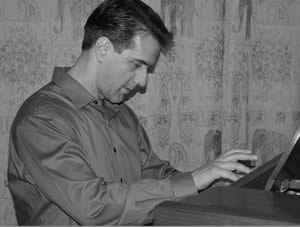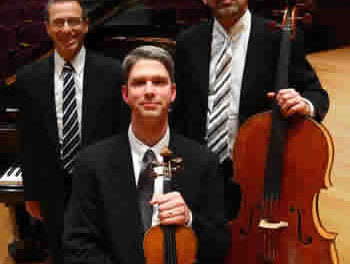The second concert in the 2013-2014 Music @ St. Alban’s concert series was billed as a program of French accordion music, but what it demonstrated was the ease and fleetness with which instruments and their music migrate across cultures. The accordion is a striking case in point.
The first instrument to be called an “accordion” was invented in Vienna in 1829, but a number of similar instruments – the Handäoline in Germany and the concertina in England, for example – were invented around that same time. Soon, the instrument had become popular throughout Europe, where it accompanied polkas and tarantellas, and even across the Atlantic, where it eventually became a staple in Cajun and mariachi bands.
Accordionist David DiGiuseppe, who leads the Triangle-based trio Musique Accordéon (with bassist Robbie Link and percussionist Beverly Botsford), did not deliver an entire history of the accordion at St. Alban’s Episcopal Church, but focused his interesting comments and the trio’s delightful music on the story of that instrument in Paris.
At the heart of French accordion music is the musette band, which played the Parisian cabarets and dance halls in the first half of the 20th century. The musette (or cabrette) was originally a bagpipe from Auvergne, in southern France, and in the 18th century its name became associated with a peasant dance. By the turn of the 19th century, musettes and bourées (another Auvergne folk dance with a long history) had become popular in urban Paris, still commonly played on the bagpipe. After an opener that included the popular “Sous le ciel de Paris,” Musique Accordéon performed a medley of three bourées, following with a medley of 19th-century Italian accordion songs that, in one instance, still recalled the bagpipe in its bass drone.
The accordion had come to cosmopolitan Paris by way of the Germans and Italians but found its real home in the musette bands, playing dance tunes of all sorts (from tangos and waltzes to, eventually, swing) in an ensemble that included piano, violin, saxophone, and banjo (another instrument with a fascinating travelogue). Musique Accordéon demonstrated the musette band’s multicultural repertoire with a Parisian waltz, a Spanish pasa doble, a simmering tango (by Kurt Weill!), and two jazz-inflected pieces, which allowed for more complex improvisations by both DiGiuseppe and Link.
French accordion music is, as DiGiuseppe proved, thoroughly polyglot, but there are some songs that we recognize as vraiment French, conjuring the cafés as well as the cabarets, the brioches and the Beaujolais. Musique Accordéon played those tunes, too – from the past (Edith Piaf‘s “L’accordéoniste” and “La vie en rose”) and the present (the soundtrack to the popular film Amélie). The audience enjoyed every minute of the entertaining program.
DiGiuseppe played his instrument with both authority and charm. By its very nature, the accordion has a somewhat limited timbral range, so it was really left to Link and, especially, Botsford to enrich the sound bed. They did so beautifully – Link alternately plucking and bowing his bass and Botsford playing a cornucopia of percussion, from cymbals and chimes to bongos and (to the absolute delight of the audience) castanets.
Music @ St. Alban’s offers an eclectic series of concerts this season. French music is followed in December by a Celtic holiday program. The Music House Chamber Players celebrate CPE Bach’s 300th birthday in February, and the North Carolina Baroque Orchestra performs in April. The season ends in early May with David Tang’s jubilant VOX choir, which will surely rock St. Alban’s sanctuary. New this year, the concerts are repeated at midday on Mondays at St. Peter’s Episcopal Church in Charlotte, with the next one of these on November 11. Music lovers in the Queen City are no doubt glad to see noontime concerts return to St. Peter’s.












